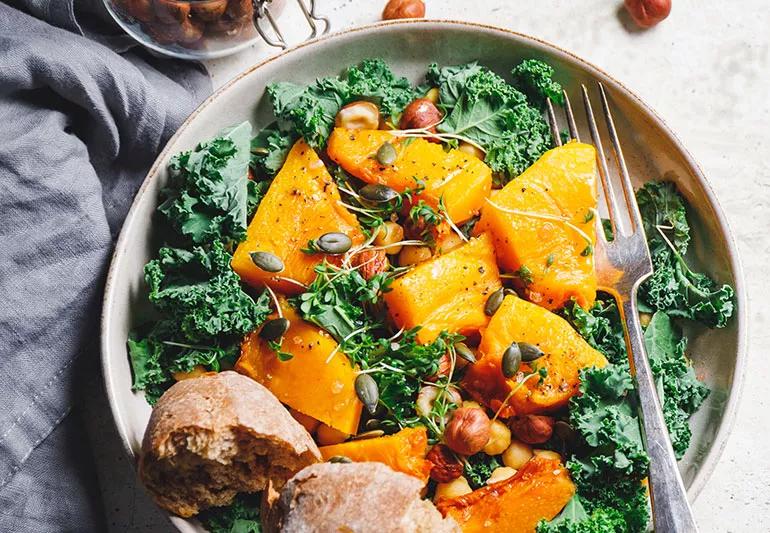Plant-based foods and healthy fats can help maintain and improve your eye health

If you have diabetes-related macular edema (DME), what you see on your plate today for breakfast, lunch and dinner may help determine how well you see future meals.
Advertisement
Cleveland Clinic is a non-profit academic medical center. Advertising on our site helps support our mission. We do not endorse non-Cleveland Clinic products or services. Policy
A diet that consistently keeps your blood sugar (glucose) at a high level can weaken blood vessels in your eyes, leading to leaks that affect your vision. Symptoms of DME typically develop gradually and worsen over time.
Consistent management of your blood sugar levels can slow the process — and nutrition is a big part of that process. As luck would have it, certain foods have a track record for boosting eye health.
So, what can you eat to maybe hold off DME and keep your peepers in tip-top shape? Let’s set a menu with the help of diabetes care and education specialist Shannon Knapp, MEd, BSN, RN, CDCES.
For starters, let’s get one thing clear: There is no “Diabetes Diet” or “DME Diet.”
“There’s nothing that says someone who has diabetes has to eat certain things,” emphasizes Knapp. “We get a lot of questions about that. People ask, ‘Am I allowed to eat this?’ But there is no one rule.”
Food is just one part of the equation when it comes to managing blood sugar, after all. Medications, exercise, stress and many other factors can drive your blood sugar up or down.
So, reducing the risk of DME or other diabetes complications often comes down to building a lifestyle that keeps blood sugar levels within a healthy range. A typical glucose level target is 80 to 130 mg/dL (milligrams per deciliter) before meals and no more than 180 mg/dL after eating.
Advertisement
“Nutrition is an important part of that process, but it’s not the ONLY part,” reiterates Knapp.
There are many similarities between “heart-healthy” and “eye-healthy” eating plans. Both lean heavily on plant-based foods (fruits, vegetables and whole grains) and healthy fats (like omega-3 fatty acids).
The connection is simple: Your heart and eyes rely on healthy arteries to function correctly, and certain foods can help keep your arteries strong.
Many of those food recommendations fall within an eating style known as the Mediterranean diet. “If anyone asks for a meal plan, that’s the one we suggest,” says Knapp. “It lines up with all of the recommendations we make.”
That’s because it includes eye-supporting foods such as:
This suggestion isn’t based on a random color preference. It’s all about the massive amount of vitamin A found in orange fruits and vegetables.
When it comes to vision, vitamin A wears a superhero cape. The antioxidant protects the outer surface (or cornea) of your eye. Your body also uses vitamin A to form pigments essential for your retinas to work properly.
Orange fruits and vegetables high in vitamin A include:
As for the orange coloring in these foods, chalk that up to beta-carotene — an orange-tinted pigment naturally found in these fruits and vegetables. Your body converts that carotenoid into vitamin A.
Know what else is often packed with vitamin A? Leafy greens such as:
These salad-bar mainstays also are solid sources of lutein and zeaxanthin, a pair of vision-aiding carotenoids, says Knapp. Research shows that both help slow the overall process of macular degeneration.
Moving through the vitamin alphabet, let’s talk about vitamin C, another antioxidant linked to better vision. (Maybe it should be identified as Vitamin See?)
Studies show that vitamin C may help delay age-related macular degeneration (AMD) in the eye. In addition, vitamin C seems to guard against the development of cataracts. (Diabetes increases the risk for cataracts, says Knapp.)
Citrus fruits such as grapefruit, lemons, tangerines and oranges are loaded with vitamin C. If citrus isn’t your thing, other sources of vitamin C include cruciferous vegetables, tomatoes and white potatoes.
What do various nuts (almonds and hazelnuts, for example), seeds (sunflower seeds and pumpkin seeds) and legumes (peanuts and beans) have in common? They’re all high in vitamin E and zinc, antioxidants that are beneficial for your peepers.
Advertisement
“Eggs for your eyes” has a certain ring to it, right? Just about every eye-aiding nutrient listed above — vitamins A and E, lutein, zeaxanthin and zinc — can be found in eggs.
Omega-3 fatty acids in fish may help reduce the formation of abnormal blood vessels linked to macular degeneration. An ocular bonus? The unsaturated fatty acid also can provide relief from dry eye.
Excellent sources of omega-3s include fish such as:
Want to build a meal using the foods listed above? It’s simple to do while following the “Plate Method” recommended by the American Diabetes Association.
The plan calls for filling your plate in three sections, listed by percentage:
Try to avoid adding salt, too, as excess sodium isn’t ideal for diabetes or DME.
Advertisement
Learn more about our editorial process.
Advertisement

Having a first-degree biological relative with this eye condition raises your risk, but other factors are at play, too

Preserving your social life and protecting your mental health are key to living well with vision loss

Start low-vision rehabilitation as soon as possible and see your retina specialist at least every six months

Getting connected to the right healthcare providers can make a big difference

Taking care of yourself helps you take care of your loved one

Installing grab bars and taping down area rugs may make navigating life with vision loss easier

Eating a balanced diet can help protect your eyes and may prevent AMD from progressing

They may help, but it depends on factors like the stage of your disease

Babies can get congested easily, but you can calm their cough by keeping them hydrated, using nasal drops and running a humidifier

Weight loss may cause loose, sagging skin and muscle loss to your rear

Several conditions, like vitiligo and fungal infection, can cause a loss of pigmentation, leading to white spots or patches on your skin